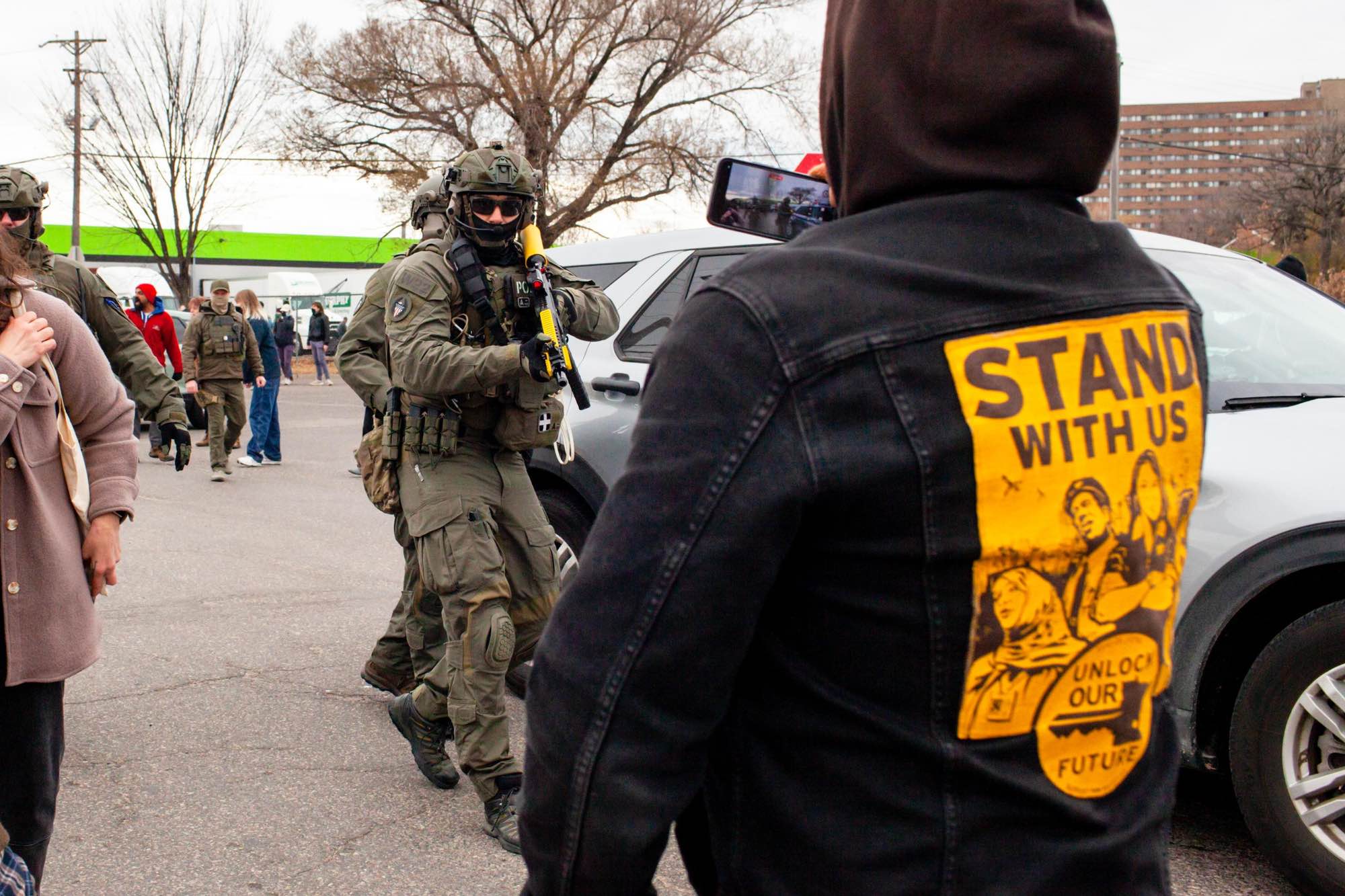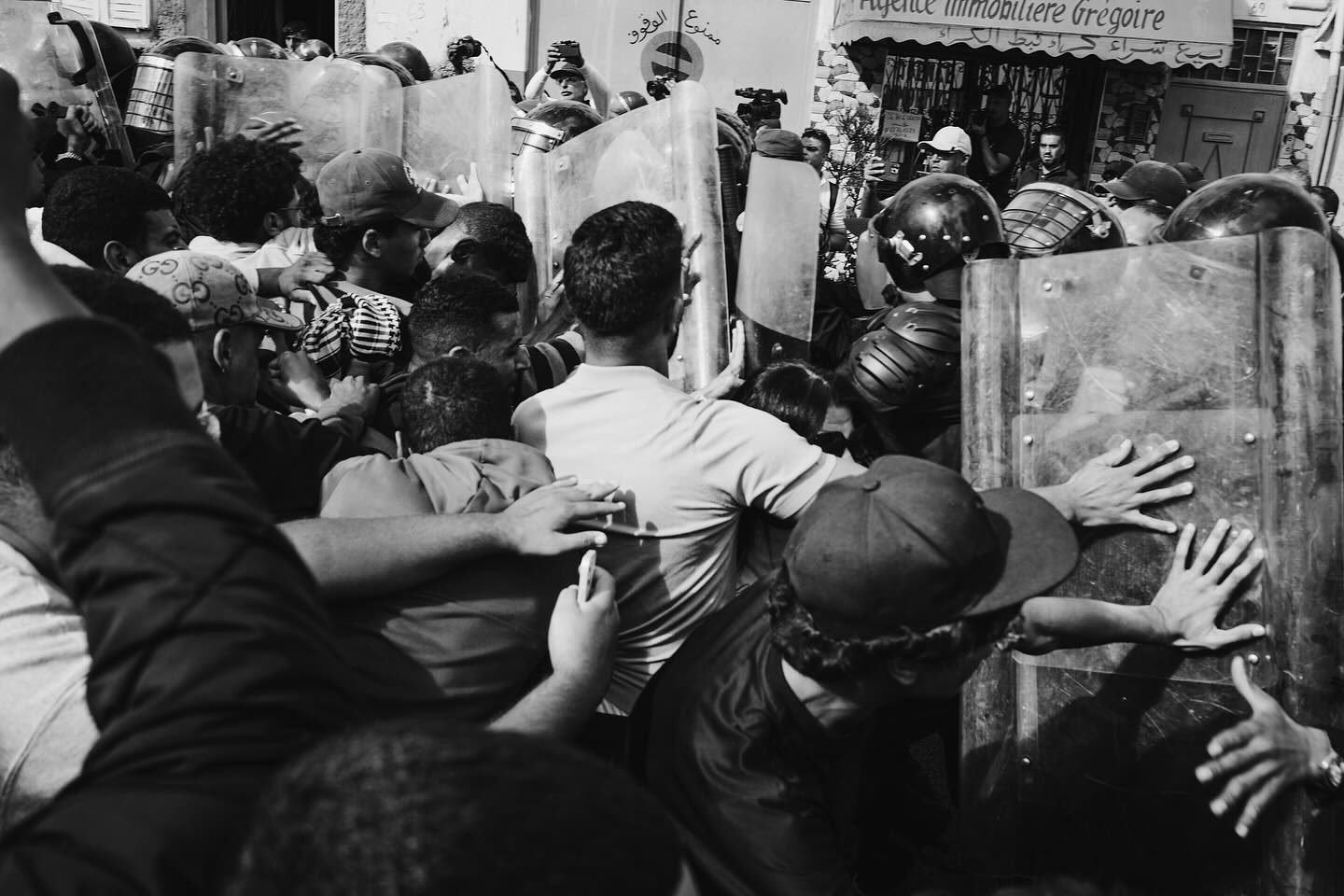
On the morning of November 18, news circulated that federal agents were gathered in St. Paul, Minnesota, presumably to carry out a raid attacking immigrants. Hundreds of people rapidly assembled to surround and impede them. Below, we present an account from a front-line participant.
This is the second time that a large number of protesters have clashed with federal agents in the Twin Cities this year. When clashes briefly broke out in Minneapolis on June 3 during a federal operation, it contributed to a wave of momentum that led to an uprising in Los Angeles the following weekend. The fact that the Trump administration has not focused federal forces on provoking a response in Minneapolis since June contradicts the supposition—still widely held among liberals—that Donald Trump and his cronies are seeking to provoke riots and believe that they will benefit from them. On the contrary, it seems more likely that Trump only desires to provoke conflicts that he can win.
Trump’s popularity has hit its lowest point thus far this term, thanks to widespread economic hardship and Trump’s entanglement in the Epstein files. As federal agencies expand their anti-immigrant operations around the country this week—targeting North Carolina, Louisiana, and Mississippi—and people weigh how to respond, a great deal hangs in the balance.

Demonstrators take the streets of Raleigh, North Carolina against ICE on November 18, 2025.
Today’s events in the Twin Cities occurred alongside United States Immigration and Customs Enforcement (ICE) attacks in Raleigh and Durham, North Carolina, after ICE deployed forces to Charlotte, North Carolina last weekend.
Like Los Angeles, Washington, DC, Chicago, and Memphis, the previous targets of ICE crackdowns, Charlotte and Durham have Black mayors and majority non-white populations. One of the chief purposes of these crackdowns is to normalize using federal forces to terrorize people, especially people of color, in order to create compassion fatigue in hopes that people will not come together in solidarity against future federal operations intended to consolidate authoritarian power. What’s new about the focus on North Carolina is that it is a swing state.
Wherever they have occurred, ICE crackdowns have not been popular with the general public or good for the economy. Kidnapping laborers who work for disproportionately low wages, who pay rent to landlords and spend their meager earnings at local corporations, is bad for business. Thus far, with the Trump has focused the crackdowns on cities controlled by Democrats as a means of exerting economic pressure while taking care not to impact his supporters. But North Carolina is among the states that the Republican Party needs to carry in the 2026 and 2028 elections—presuming that elections continue to determine who holds power.
On the heels of Democrats’ electoral victories and subsequent spineless capitulation ending the government shutdown, the decision to begin targeting swing states suggests that the Trump administration is not concerned about electoral blowback—because whatever elections Democratic politicians might win, they have shown that they will collapse under pressure. This implies that the Trump administration does not intend to leave power voluntarily.
If that is true, it only makes the acts of resistance that took place today in St. Paul more important. If Donald Trump and his henchmen intend to retain power by force alone, it is essential to build the capacity to confront them in the streets. Trump’s efforts to use immigration raids to subdue the population could have the opposite effect, bringing together communities through rapid response networks to become capable of mass resistance. If we do not wish to live under Trump’s reign for the rest of his life, this may be our only hope.

Demonstrators take the streets of Raleigh, North Carolina against ICE on November 18, 2025.
St. Paul, Minnesota, November 18
On Tuesday morning, November 18, immediately before 9 am, an alert circulated over a number of rapid response networks in the Twin Cities saying that cars belonging to ICE agents had been seen in the parking lot of Newell Park in St. Paul. By the time most people who responded to the alert got there, the cars had disappeared, with the possible exception of a few trucks.
Then a second alert circulated, telling people that federal agents from the Drug Enforcement Administration (DEA), the Federal Bureau of Investigation (FBI), and ICE had been sighted at a warehouse called Bro-Tex in the Midway neighborhood of St. Paul, a short distance away. People began to arrive there shortly before 9:30 am.
As people arrived at the second location, they found an industrial area with freight trucks, warehouses, and large open spaces cordoned off with crime scene tape. Between twenty and thirty agents were gathered outside by their vehicles, representing multiple federal agencies including ICE, DEA, FBI, and Homeland Security Investigations (HSI, the principal criminal investigative arm of ICE). More and more protesters were showing up, filling in from every direction, until the number reached at least 200 people. It was hard to keep abreast of developments in the chaos across a fairly large area. More agents and crime scene tape were seen far down at the end of the industrial street, so some protesters moved there, hoping to block off all lines of escape for the agents.
For approximately forty minutes, the federal agents simply maintained the perimeter while people yelled at them, chanted, and occasionally tore down the crime scene tape. Then other agents came out of the building and quickly got into vans. Some of them may have been able to leave quickly in a caravan, taking away an unknown number of detainees. This made people furious; the situation escalated as the protesters sought to prevent more agents from getting away. Some protesters moved into the cordoned-off areas, tore down the cordons, chased after the agents, and surrounded the agents in their cars as they attempted to leave.

At this point, the agents began to pepper-spray the crowd. They did so repeatedly. As people chased away federal agents in one car, someone smashed its back window and people kicked it from all sides. Scuffles broke out as people attempted to form chains to obstruct the cars, coming back together repeatedly after the agents forcibly separated them. Some people parked their personal cars in the path of the agents to prevent them from leaving. Eventually, the last two of an estimated total of twenty cars driven by federal agents were chased out as people kicked them, ripped off pieces of the vehicles, and yelled at the agents on foot around the cars. The final image that the agents saw as they sped away was an angry crowd screaming and throwing projectiles, as someone in a black ski mask with a black smoke bomb walked confidently towards them.
Near the end of the events, before we went back to check on those who had been beaten and pepper-sprayed, a few individuals in the crowd yelled out that all the broken windows and rock throwing were giving the feds exactly what they wanted. “Look what is already happening now,” others responded. “We are done with this shit. We have to fight back.” The violence that the Trump administration is perpetrating against people is not the consequence of the resistance that people are engaging in; it is the consequence of the fact that not enough people are engaging in open resistance yet.
The crowd did not ultimately succeed in preventing the federal agents from leaving, though they were delayed. It is difficult to tell whether the response prevented any detentions. Nonetheless, it was a victory that so many people responded so quickly in the middle a workday and that so many of them were prepared to put up a fight to stop them from kidnapping our neighbors.

Pepper balls strike demonstrators blocking federal agents driving vehicles as they withdraw from a raid targeting immigrants in St. Paul. Photograph by Nicole Neri, Minnesota Reformer.
Today’s events represent the fiercest rapid response to federal agents since people chased them out of Minneapolis last June. Other raids have occurred in the intervening months, but most people did not hear about them until they were over. The fact that this one was immediately reported, drawing such a quick response, suggests that the rapid response network has spread more widely and illustrates its effectiveness.
This comes shortly after Kristi Noem spoke at press conference and briefing in the Twin Cities about ICE operations in the area. Many people took that to mean that a possible increase of ICE activity was imminent. At minimum, the feds were signalling support for ICE activity in our community. This spurred an increase in rapid response trainings across the metropolitan area, with protest trainings ranging from how to deal with tear gas to how to halt bleeding. There were autonomously organized trainings about what to do in response to ICE sightings; organizers distributed 3D-printed whistles to hundreds of people at each session. This escalation in preparedness may have contributed to popular readiness to respond to today’s raid.
Some tentative conclusions:
- Don’t be caught off guard just because your city isn’t currently being occupied the way that Chicago and Charlotte are. Get a go bag and be prepared to move quickly when the time comes.
- Join and expand the rapid response networks. We likely heard about this raid, as opposed to others that went undetected, because the rapid response network here has achieved wider coverage, reaching more people who are able to report a raid while it is happening. Had no one reported the park full of white vans, people most likely wouldn’t have shown up to confront them.
- Escalation was the popular option today; people were trying everything at once. Very few people sought to impede others who were fighting back how they saw fit and often they witnessed the effectiveness of confrontation.
As Dianne Di Prima wrote,
“NO ONE WAY WORKS, it will take all of us shoving at the thing from all sides to bring it down.”

The faces of evil.



